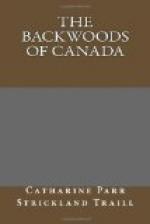A very beautiful plant of the lily tribe abounds both in our woods and clearings; for want of a better name, I call it the douri-lily, though it is widely spread over a great portion of the continent. The Americans term the white and red varieties of this species, the “white” and “red death.” The flower is either deep red, or of a dazzling white, though the latter is often found stained with a delicate blush-pink, or a deep green; the latter appears to be caused by the calix running into the petal. Wherefore it bears so formidable a name has not yet transpired. The flower consists of three petals, the calix three; it belongs to the class and order Hexandria monogynia; style, three-cleft; seed-vessel of three valves; soil, dry woods and cleared lands; leaves growing in three, springing from the joints, large round, but a little pointed at the extremities.
We have lilies of the valley, and their cousins the Solomon’s seals, a small flowered turk’s-cap, of pale primrose colour, with an endless variety of small flowers of the lily tribe, remarkable for beauty of foliage or delicacy of form.
Our Ferns are very elegant and numerous; I have no less than eight different specimens, gathered from our immediate neighbourhood, some of which are extremely elegant, especially one that I call the “fairy fern,” from its lightness. One elastic stem, of a purplish-red colour, supports several light branches, which are subdivided and furnished with innumerable leaflets; each leaflet has a footstalk, that attaches it to the branch, of so slight and hair-like a substance that the least breath of air sets the whole plant in motion.
Could we but imagine Canada to have been the scene of fairy revels, we should declare that these graceful ferns were well suited to shade the elfin court of Oberon and Titania.
When this fern first appears above the ground, it is scarcely to be distinguished from the decaying wood of the fallen pines; it is then of a light reddish brown, curiously curled up. In May and June, the leaves unfold, and soon assume the most delicate tint of green; they are almost transparent: the cattle are very fond of this fern.
The mocassin flower or lady’s-slipper (mark the odd coincidence between the common name of the American and English species) is one of our most remarkable flowers; both on account of its beauty and its singularity of structure. Our plains and dry sunny pastures produce several varieties; among these, the Cypripedium pubescens, or yellow mocassin, and the C. Arietinum are the most beautiful of the species. The colour of the lip of the former is a lively canary yellow, dashed with deep crimson spots. The upper petals consist of two short and two long; in texture and colour resembling the sheath of some of the narcissus tribe; the short ones stand erect, like a pair of ears; the long or lateral pair are three times the length of the former, very narrow, and elegantly twisted,




